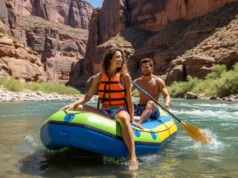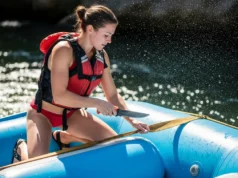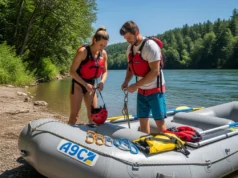In this article
The moment a swimmer is swept into the current, the distance between your hand and their grasp feels a mile wide. In that critical window, the river rescue throw bag you deploy is your only connection—and its performance in a swiftwater rescue is non-negotiable. This guide isn’t just a review of popular throwbags; it’s a quantitative analysis designed to demystify rescue dynamics, empowering you to choose a bag rated not just for a throw, but for the specific, high-stakes reality of a raft rescue. We’ll discover why a rope’s tensile strength below 2,000 lbs is a critical liability for boat rescue and how our River Rafting Load Rating (RRLR) system simplifies this complex spec. You will learn to spot a “clean,” snag-free design versus a hazardous one, ensuring your important rescue gear doesn’t become an entrapment risk. We will see our top-rated throw bags matched to three distinct user applications: the Professional Guide, the Weekend Warrior, and the Ultralight Expeditionist, and understand the critical trade-offs between rope properties like material, length, and diameter to build a complete whitewater safety system.
How to Choose the Right River Rescue Throw Bag: An Expert’s Framework
Why is Rope Strength (MBS) the Most Critical Specification?
Minimum Breaking Strength, or MBS, is the ultimate static load a rope can handle before it fails. While a simple swimmer rescue during recreational paddling places relatively low stress on a rope, the dynamics of a raft rescue—specifically unpinning a loaded raft—change everything. The immense force generated by moving water on a pinned raft can be staggering; even a modest current can exert over 2,200 pounds of force, establishing a clear safety threshold that many recreational ropes simply cannot meet. This reality is compounded by a factor every rescuer must account for: knots.
The very knots we rely on to build a mechanical advantage system, a skill learned in any proper swiftwater rescue course, can significantly reduce a rope’s strength, often by 30-60%, which reinforces the absolute need for a high initial MBS. To make this tangible, we developed the River Rafting Load Rating (RRLR) system. This simple framework translates abstract MBS numbers into a clear, actionable rating for real-world scenarios: Rescuing a Swimmer (SR), Light Boat Unpin (LBU), and the high-load world of Heavy Raft Mechanical Advantage (HRMA). While strength is paramount, a rope is useless if the bag’s design introduces its own dangers.
What Makes a ‘Clean’ and Safe Throw Bag Design?
A rescue tool must never create a greater hazard than the one it’s meant to mitigate. This is the “Clean Line Principle,” a non-negotiable standard for any whitewater rescue gear used in moving water. It means the bag must have a snag-free design, free of key hazards like large external loops, extraneous handles, or knots on its exterior that could easily entangle a swimmer or catch on a rock. A critical point of concern is the bottom anchor loop, or bag end loop. A safe, modern design will feature a small, sheathed, or internal loop that is too small for a hand to pass through, preventing a catastrophic entrapment scenario.
For wearable, waist-mounted throw bags, this principle extends to the rescuer themselves; the non-negotiable need for a quick-release buckle on the waist belt is the only thing that can prevent a rescuer from being dangerously pulled underwater if their rope becomes snagged. Adherence to these design standards, as outlined by safety organizations like the NFPA, is a key differentiator between a professional tool and a potential liability. This is why integrating with your personal flotation device (PFD) safely is part of a complete system. Once you’ve confirmed a bag is both strong and safe, you can evaluate its handling characteristics, starting with length and diameter.
Pro-Tip: Before your first trip with a new throw bag, take a knife and carefully cut off any unnecessary external tags, plastic clips, or decorative loops. Smooth is safe. Anything that can form a loop is a potential snag hazard. Your goal is a bag that can slide cleanly over any surface, including a swimmer’s PFD.
How Do Rope Length and Diameter Affect Performance?
Choosing the right rope length involves a trade-off between throwing distance and manageability. Longer ropes, typically 75 feet, offer greater reach for wide rivers and are essential for building mechanical advantage systems, but they create heavier, bulkier bags that are harder to throw accurately. Shorter ropes, from 50 to 65 feet, are often preferred for kayaking or on narrow rivers, resulting in a more compact and lightweight package. Similarly, rope diameter is a balance between ease of handling and weight. A thicker 3/8″ rope provides a superior, more secure grip for cold hands or a panicked swimmer and is easier to manage in hauling systems. This adds significant weight and bulk. Thinner ropes, between 1/4″ and 5/16″, are much lighter and more compact but offer a poor grip that can be a serious liability for an exhausted swimmer. The right dimensions depend entirely on the intended use and how equipment dimensions affect leverage and control.
Which Rope Material is Right for My Needs?
The final piece of the puzzle is the material science that dictates the rope’s core properties. The most common and affordable rope material is Polypropylene. It is prized for its excellent floatation and soft feel, but its low tensile strength and low melting point make it suitable only for swimmer rescue scenarios. The high-performance option is Spectra® or Dyneema®, brand names for a polymer that is exceptionally strong for its weight and does not absorb water, though it is significantly more expensive. The best-of-both-worlds approach is a Kernmantle Construction, which uses a strong Spectra or Dyneema core protected by a buoyant, easy-to-grip polypropylene sheath. This is the standard for professional-grade throw bags designed for the highest loads.
Pro-Tip: Regardless of material, UV rays are the silent killer of all life-saving ropes. Store your throw bag out of direct sunlight, either in a dry bag or a dedicated gear box. A rope that feels stiff or has faded, washed-out colors has likely suffered significant sun damage and should be retired immediately.
Our Selection Process: How We Built This Guide
To build absolute trust, we want to be transparent about our rigorous research and curation process. This guide is the result of a comprehensive analysis of professional rescue protocols, product engineering, and aggregated expert feedback; our recommendations are driven by data, not brand loyalty. Every product we considered was systematically scored against nine criteria: five qualitative performance factors (Deployment, Repacking Ease, Safety, Durability, Handling) and four objective technical specifications (MBS, Length, Diameter, Material).
We started with a market-wide survey of over 25 throw bags, then filtered this list down to the top performers that align with the specific needs of our three core user personas, ensuring each recommendation is a best-in-class solution for its intended user. If you choose to purchase a product through one of our links, we may earn a small commission at no extra cost to you. This helps support our work, but our primary goal is to provide you with the best, most objective information possible.
The Best River Rescue Throw Bags of 2025: Our Top Recommendations for Every Need
Our Top Picks for The Professional Guide / Swiftwater Technician
For the professional guiding or swiftwater rescue technician who demands documented reliability and maximum performance for high-stakes rescues, this equipment is the gold standard. This is the guides choice for equipment. These bags are built with the strongest materials like Cordura fabric, adhere to the strictest safety standards like an NFPA rating, and are designed for the rigors of daily use in complex mechanical advantage systems and swiftwater scenarios where failure is not an option.
Our Top Picks for The Weekend Warrior / Private Boater
The weekend warrior and private boater need a versatile, reliable workhorse. This user is looking for the best all-around value: a boat bag—which can also function as a kayak throw bag—with enough strength for common rescues and a user-friendly design that’s easy to pack and throw. This category represents the best beginner and best intermediate throw bag options on the market.
Our Top Picks for The Ultralight Expeditionist / Packrafter
For the adventurer counting every gram—the packrafter engaged in expedition rafting, or the backcountry kayaker—equipment must be ultralight and multi-functional. This packrafting category prioritizes minimal weight and packed volume above all else, often through the use of advanced materials like Dyneema Composite Fabrics and worn-on-body designs that integrate directly with a PFD for a rescue-ready device.
Conclusion
Choosing the right throw bag is a foundational step in river safety. It’s about matching the tool to the task, and understanding that even the best gear is no substitute for training. Knowing how to use a throw bag for rescue is as critical as owning one. For any raft rescue scenario, an MBS over 2,200 lbs is a critical safety baseline; standard polypropylene ropes are for swimmer rescue only. Always prioritize a “clean” design by inspecting a bag for a small, non-entrapment bottom loop and the absence of external snag points, and for wearable bags, a quick-release belt is mandatory. Finally, understand the trade-offs. The ideal rope length, diameter, and material are a compromise between reach, weight, grip, and strength, and your specific needs will dictate the right balance. Now that you have the framework, check your gear, practice your throw, and share this guide with your boating crew to ensure everyone on the water is prepared and safe.
Frequently Asked Questions
What is the minimum strength (MBS) I need for a raft rescue throw bag?
For any scenario that could involve unpinning a loaded raft, setting up a mechanical advantage system, or lining rafts through a tricky rapid, you need a rope with a Minimum Breaking Strength of at least 2,200 lbs (approx. 10 kN). This establishes a baseline of safety when dealing with the immense forces of moving water against a boat. For this purpose, we recommend bags like the River Station B.O.A.T. Classic or the NRS NFPA Rope Rescue Bag.
Do I need a waist-worn bag or a boat bag?
This depends on your role, your boat, and your preferred storage method. Raft guides and instructors often prefer a waist-worn bag for instant access to a swimmer, while private rafters typically use a larger, stronger boat bag, often stored on a boat thwart, as their primary tool. Many professionals use a two-bag system: a compact waist bag like the Salamander Guide Throw Bag for immediate swimmer response and a robust boat bag for complex rescues like unpinning a raft.
Is a Spectra or Dyneema rope worth the extra cost?
If you need a rope that is both ultralight and exceptionally strong for its weight, then yes, the performance of Spectra/Dyneema is worth the investment. This is especially true for ultralight expeditionists and packrafters who need to minimize every gram without compromising on strength. For these users, a bag with a high-tech rope like Sterling Ultraline, which has a Spectra/Dyneema core, is the top choice.
How often should I inspect or replace my throw bag?
You should inspect your throw bag rope for significant abrasion, sun damage (fading, stiffness), or chemical contamination before every single trip, and replace it if any damage is found. The integrity of the rope is paramount. Proper storage provides essential UV protection and extends the life of your gear. Regardless of use, most manufacturers recommend retiring any life-safety rope after 5-10 years due to the natural material degradation that occurs over time, even in storage.
Risk Disclaimer: Whitewater rafting, kayaking, and all related river sports are inherently dangerous activities that can result in serious injury, drowning, or death. The information provided on Rafting Escapes is for educational and informational purposes only. While we strive for accuracy, the information, techniques, and safety advice presented on this website are not a substitute for professional guide services, hands-on swiftwater rescue training, or your own critical judgment. River conditions, including water levels, currents, and hazards like strainers or undercut rocks, change constantly and can differ dramatically from what is described on this site. Never attempt to navigate a river beyond your certified skill level and always wear appropriate safety gear, including a personal flotation device (PFD) and helmet. We strongly advise rafting with a licensed professional guide. By using this website, you agree that you are solely responsible for your own safety. Any reliance you place on our content is strictly at your own risk, and you assume all liability for your actions and decisions on the water. Rafting Escapes and its authors will not be held liable for any injury, damage, or loss sustained in connection with the use of the information herein.
Affiliate Disclosure: We are a participant in the Amazon Services LLC Associates Program, an affiliate advertising program designed to provide a means for us to earn advertising fees by advertising and linking to Amazon.com. As an Amazon Associate, we earn from qualifying purchases. We also participate in other affiliate programs and may receive a commission on products purchased through our links, at no extra cost to you. Additional terms are found in the terms of service.





